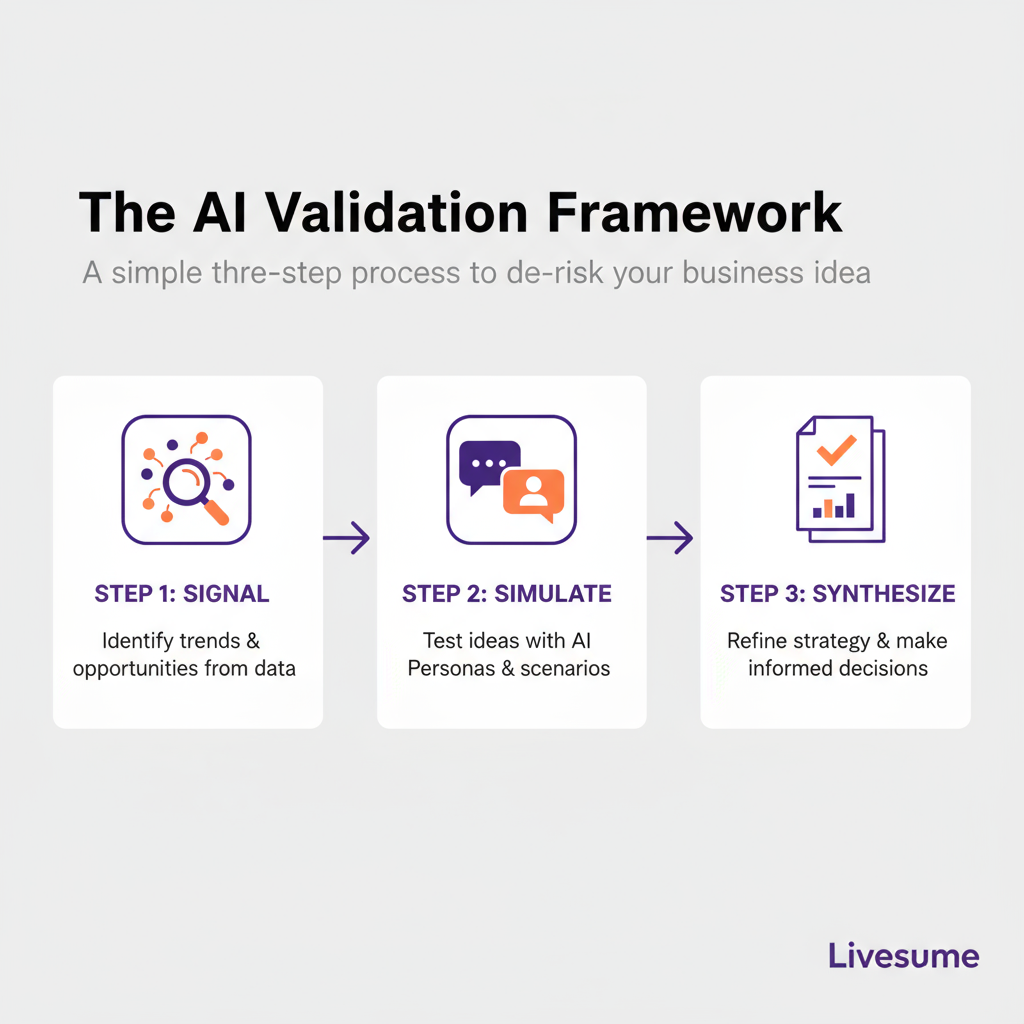You have a brilliant idea. It solves a real problem, the domain name is available, and you can already picture the final product. But there's a nagging fear in the back of your mind: what if nobody buys it? Wasting months, or even years, building something nobody wants is the entrepreneur's worst nightmare. This guide shows you how to use specific AI tools and frameworks to stress-test your idea, find your first customers, and build with confidence—before you write a single line of code.
Key Takeaways
- De-risk Your Launch: Use AI to gather unbiased market data and identify fatal flaws in your idea before you invest significant time and money.
- Go from Guesswork to Data: Replace anecdotal feedback from friends and family with structured insights synthesized from thousands of data points.
- Accelerate Product-Market Fit: Simulate customer interviews and analyze feedback at a scale and speed impossible through manual methods alone.
- Find Your Niche: Let AI sift through online communities like Reddit and industry forums to pinpoint the exact language and pain points of your ideal customer.

Why Manual Validation Falls Short (And How AI Fixes It)
Traditional idea validation is slow and often biased. You run a survey, get 50 responses, and try to find a pattern. You interview a few friends who tell you your idea is "great" to avoid hurting your feelings. The feedback is limited, tainted by personal relationships, and takes weeks to gather.
AI flips this model on its head. Instead of asking a small group for their opinions, you can analyze what thousands of people are *already* saying in public forums, reviews, and social media. It's the difference between asking "Would you buy this?" and listening in on a thousand candid conversations about the exact problem you want to solve.
The AI Validation Framework: Signal, Simulate, Synthesize
A structured approach is key. Don't just ask an AI "Is my business idea good?" That's a recipe for generic advice. Instead, we’ll use a three-step framework to get actionable intelligence.
Step 1: Find the Signal (Uncover Real Problems)
The first step is to confirm people are actively and emotionally discussing the problem you aim to solve. This is where you hunt for the "signal"—the raw, unfiltered complaints, wishes, and workarounds your target audience posts online.
Your goal is to collect qualitative data at scale. Use AI research tools like Perplexity or the browsing mode in ChatGPT-4o to scan specific subreddits, forums, and review sites.
Example Prompt: "Analyze the top 10 most commented threads in r/freelancewriters from the last 6 months. Identify the top 5 most frequently mentioned challenges related to finding new clients. Extract direct quotes for each challenge."
- Before: You have a hunch that freelance writers struggle with client acquisition. Your evidence is a few blog posts you've read.
- After: You have a categorized list of 5 specific pain points, supported by 50+ direct quotes from writers detailing their frustrations with "feast or famine" cycles and low-quality job boards. Your hunch is now a data-backed insight.
Step 2: Simulate the Customer (Stress-Test Your Solution)
Now that you have evidence of the problem, you need to test your proposed solution. AI can create incredibly detailed customer personas and then "role-play" as them, allowing you to conduct simulated interviews.
First, feed the data from Step 1 into an advanced LLM like Claude 3 Opus or ChatGPT-4o. Ask it to create three distinct customer personas based on the extracted pain points. Give them names, job titles, goals, and frustrations.
Then, "interview" your AI personas. Pitch your solution and ask probing questions.
Example Prompt: "You are 'Sarah,' a freelance graphic designer with 5 years of experience who struggles with unpredictable income. I'm going to pitch you a service. Ask me at least three skeptical questions an actual freelancer would have, focusing on price, ROI, and time commitment."
This process forces you to confront objections and refine your value proposition before you ever speak to a real person. It’s a powerful way to iron out the kinks in your messaging.

Step 3: Synthesize the Data (Build Your Validation Report)
You've gathered the signal and simulated the customer. Now it's time to bring it all together. Consolidate your research, quotes, and simulated interview transcripts into a single document and use an AI to synthesize it into a final validation report.
Example Prompt: "Review the attached research notes, quotes, and interview transcripts. Act as a startup advisor. Score my business idea from 1-10 on problem severity, market size, and solution viability. Summarize the biggest strengths, weaknesses, and a key recommendation for the next step."
- Before: You have a messy collection of notes and a vague "good feeling" about your idea.
- After: You have a concise, 1-page report that scores your idea against key metrics, lists the most critical risks, and suggests a clear path forward—like focusing on a specific niche you discovered during the research.
Your Idea is Validated. What's Next?
Once you have a data-backed concept, you need a home for it. The fastest way to start gathering real-world interest is with a focused, professional-looking landing page. Build one in minutes and start collecting emails for your launch.
Build Your Landing Page Now
Which AI Should You Use? A Quick Comparison
Not all AIs are created equal. For business validation, you need tools that can handle deep research and nuanced analysis.
- For Research (Finding the Signal): Perplexity AI is a standout. It's designed for research, cites its sources, and is less likely to hallucinate than general-purpose chatbots. It's perfect for scanning forums and publications.
- For Analysis & Synthesis: Claude 3 Opus or ChatGPT-4o are your best bets. Claude often excels at handling large amounts of text (like pasting in multiple articles or transcripts) and providing nuanced, well-structured summaries. ChatGPT-4o is a fantastic all-rounder, especially for creative tasks like persona generation.
- For Speed: Don't underestimate the free versions for quick checks, but for a serious validation project, the small monthly investment for a pro plan is well worth it for the enhanced accuracy and deeper capabilities.
Frequently Asked Questions
Can AI tell me if my business idea will be profitable?
No, AI cannot predict profitability with certainty. It can, however, analyze market demand, identify competitor weaknesses, and estimate the severity of the problem you're solving. It provides data to help *you* make a more informed decision, but it's not a crystal ball.
Is AI-driven validation better than talking to real customers?
It's not better, it's a powerful *precursor*. Use AI to do 80% of the foundational research quickly. This ensures that when you *do* talk to real customers, you're asking smarter, more targeted questions based on data, not just hunches.
How much does it cost to use AI for this?
You can do a surprising amount for free using tools like Perplexity's free version or the basic ChatGPT. However, for deep analysis, a subscription to a pro plan (typically $20-$30/month) for a tool like ChatGPT Plus or Claude Pro is highly recommended for one month to complete your research.
What's the biggest mistake people make when using AI for validation?
Asking vague, high-level questions like "Is my idea for a pet-sitting app good?" Instead, you need to use specific, targeted prompts to analyze micro-problems, like "What are the top 3 safety concerns parents mention in reviews for the Rover app?"
Can I validate a service-based business idea this way?
Absolutely. The process is identical. Use AI to find signals of demand for a service—look for forum posts where people ask "Can anyone recommend a good X?" or complain about the quality of existing providers. A strong signal of need is the first step to a successful services page.
Turn Your Validated Idea Into Action
An idea, even an AI-validated one, is worthless without execution. The data you've gathered is not just a report; it's the foundation for your entire go-to-market strategy. Here's how to move forward:
- Build a Minimum Viable Presence: Use your validation report to write the copy for a simple landing page. You know the exact pain points, so speak directly to them.
- Start an Email List: Add a simple email signup form to your page. This is your list of potential first customers. The number of signups is your next layer of validation.
- Share Your Journey: Create a professional page that establishes your credibility as the founder. You don't need a huge social media following, just a central hub that shows you're serious.
Stop dreaming and start validating. By using AI as your research partner, you can stop building in the dark and start creating a business you *know* people are waiting for.